key SUZUKI GRAND VITARA 2008 3.G Operating Manual
[x] Cancel search | Manufacturer: SUZUKI, Model Year: 2008, Model line: GRAND VITARA, Model: SUZUKI GRAND VITARA 2008 3.GPages: 40, PDF Size: 1.23 MB
Page 3 of 40
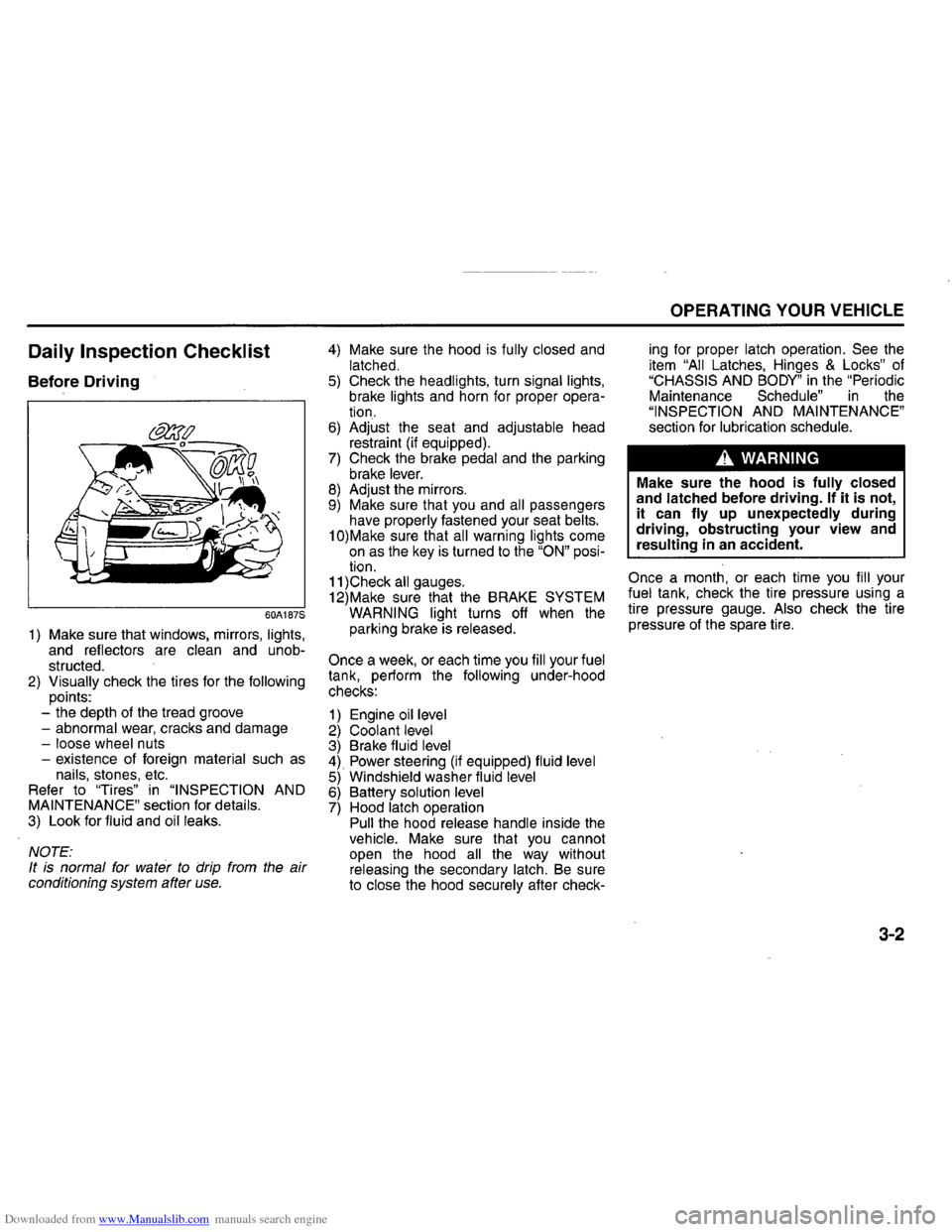
Downloaded from www.Manualslib.com manuals search engine Daily Inspection Checklist
Before Driving
60A187S
1) Make sure that windows, mirrors, lights, and reflectors are clean and unob
structed.
2) Visually check the tires for the following points:
- the depth of the tread groove
-
abnormal wear, cracks and damage
-loose wheel nuts
- existence of foreign material such as nails, stones, etc.
Refer to "Tires" in "INSPECTION AND MAINTENANCE" section for details. 3) Look for fluid and oil leaks.
NOTE:
It is normal for water to drip from the air conditioning system after use.
4) Make sure the hood is fully closed and latched. 5) Check the headlights, turn signal lights, brake lights and horn for proper opera
tion.
6) Adjust the seat and adjustable head
restraint (if equipped).
7) Check the brake pedal and the parking
brake lever. 8) Adjust the mirrors. 9) Make sure that you and all passengers
have properly fastened your seat belts.
10)Make sure that all warning lights come on as the key is turned to the "ON" posi
tion.
11 )Check all gauges.
12)Make sure that the BRAKE SYSTEM
WARNING light turns off when the
parking brake is released.
Once
a week, or each time you fill your fuel tank, perform the following under-hood
checks:
1) Engine oil level 2) Coolant level 3) Brake fluid level 4) Power steering (if equipped) fluid level 5) Windshield washer fluid level 6) Battery solution level 7) Hood latch operation Pull the hood release handle inside the vehicle. Make sure that you cannot
open the hood all the way without releasing the secondary latch. Be sure
to close the hood securely after check-
OPERATING YOUR VEHICLE
ing for proper latch operation. See the
item "All Latches, Hinges & Locks" of "CHASSIS AND BODY" in the "Periodic Maintenance Schedule" in the "INSPECTION AND MAINTENANCE" section for lubrication schedule.
A WARNING
Make sure the hood is fully closed
and latched before driving. If it is not,
it can fly up unexpectedly during
driving,
obstructing your view and
resulting in an accident.
Once a month, or each time you fill your fuel tank, check the tire pressure using a
tire pressure gauge. Also check the tire
pressure of the spare tire.
3-2
Page 5 of 40
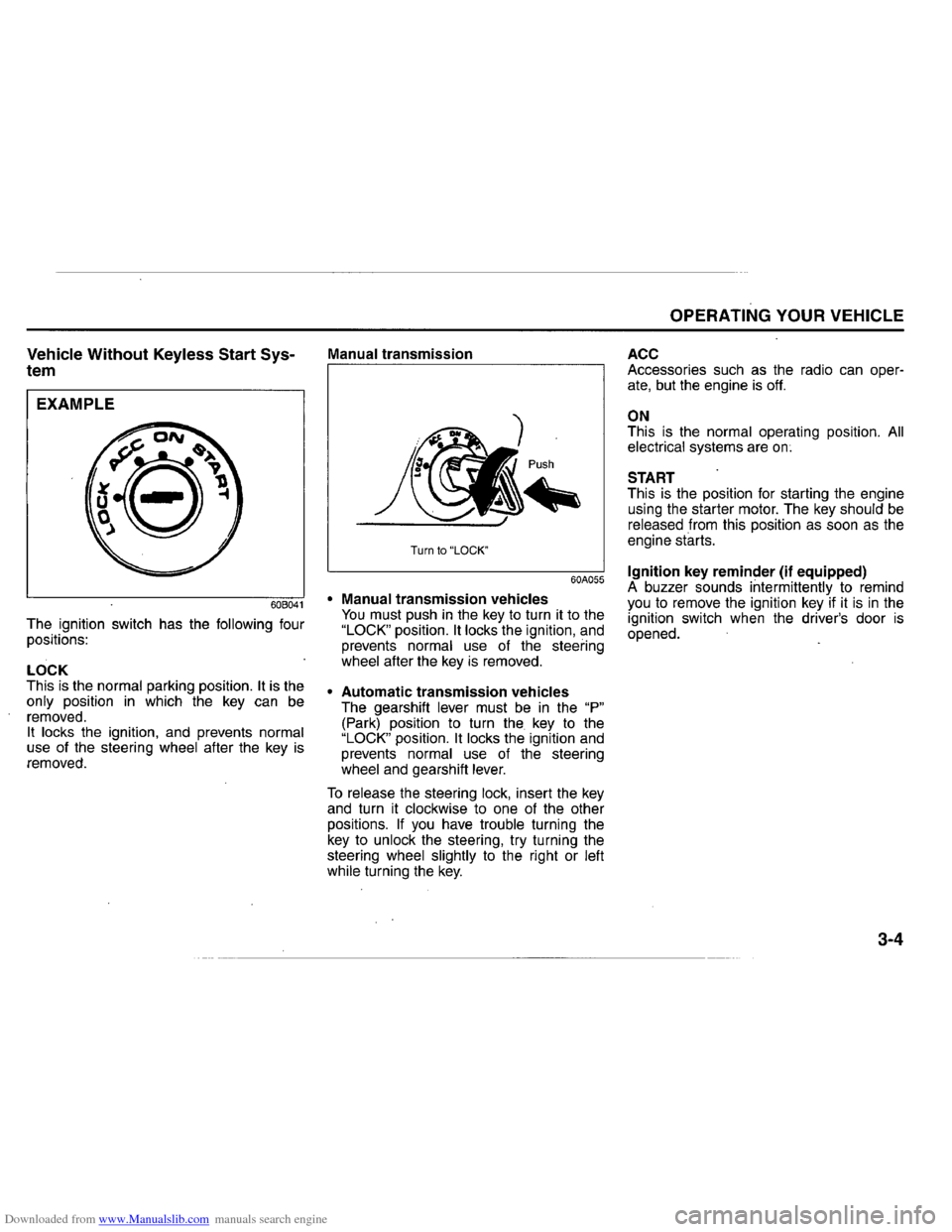
Downloaded from www.Manualslib.com manuals search engine Vehicle Without Keyless Start System
EXAMPLE
608041
The ignition switch has the following four
positions:
LOCK This is the normal parking position. It is the
only position in which the key can be
removed.
It locks the ignition, and prevents normal use of the steering wheel after the key is
removed.
Manual transmission
Turn to "LOCK"
60A055
• Manual transmission vehicles You must push in the key to turn it to the "LOCK" position. It locks the ignition, and
prevents normal use of the steering
wheel after the
key is removed.
• Automatic transmission vehicles The gearshift lever must be in the "P" (Park) position to turn the. key to the "LOCK" position. It locks the ignition and
prevents normal use of the steering
wheel and gearshift
lever.
To release the steering lock, insert the key and turn it clockwise to one of the other
positions. If you have trouble turning the key to unlock the steering, try turning the
steering wheel slightly to the right or left
while turning the key.
OPERATING YOUR VEHICLE
ACC Accessories such as the radio can operate, but the engine is off.
ON This is the normal operating position. All electrical systems are on;
START This is the position for starting the engine
using the starter motor. The key should be released from this position as soon as the
engine starts.
Ignition key reminder (if equipped) . A buzzer sounds intermittently to remind you to remove the ignition key if it is in the
ignition switch when the driver's door is opened.
3-4
Page 6 of 40
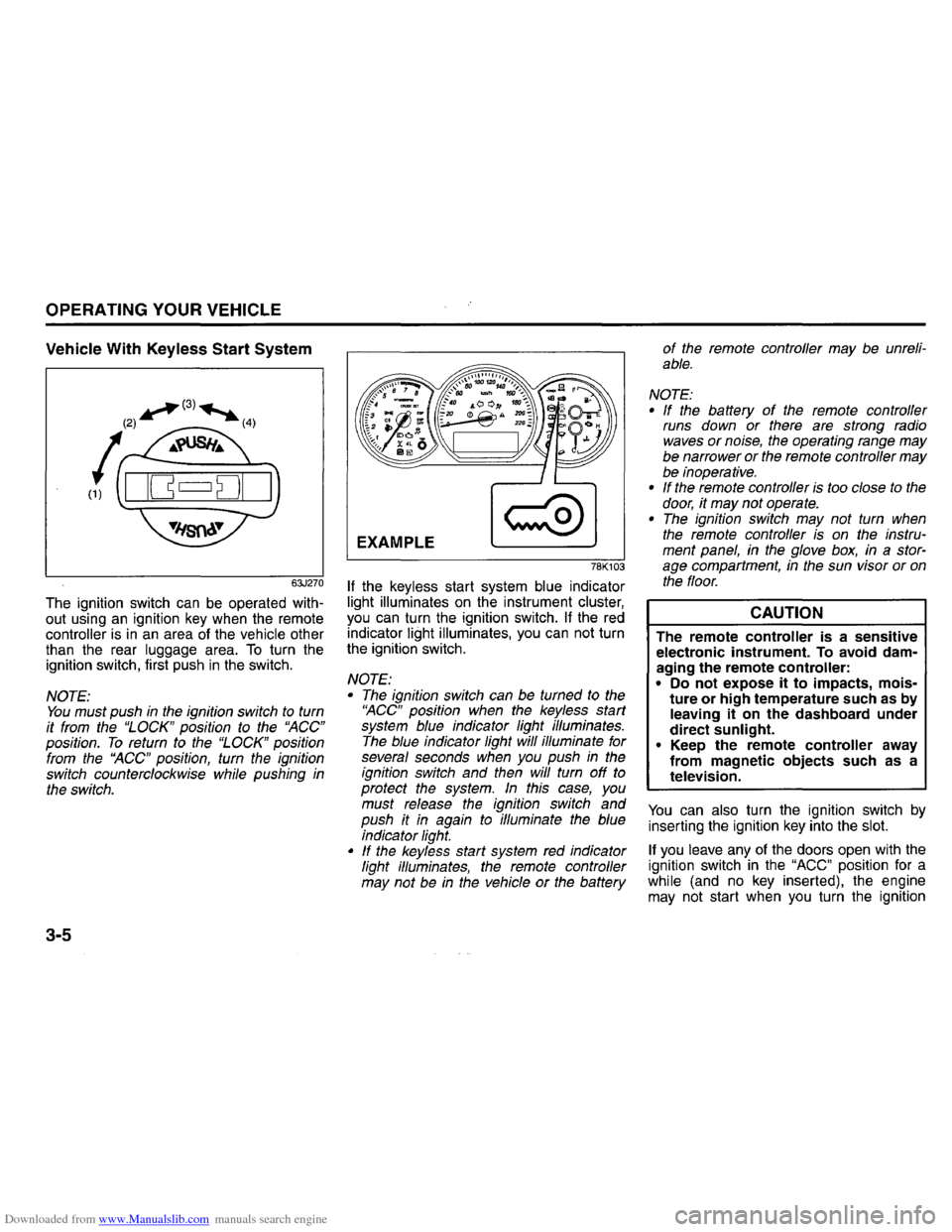
Downloaded from www.Manualslib.com manuals search engine OPERATING YOUR VEHICLE
Vehicle With Keyless Start System
63J270
The ignition switch can be operated with
out using an ignition key when the remote controller is in an area of the vehicle other
than the rear luggage area. To turn the
ignition switch, first push in the switch.
NOTE: You must push in the ignition switch to turn
it from the "LOCK" position to the "ACC" position. To return to the "LOCK" position
from the '~CC" position, turn the ignition
switch counterclockwise while pushing in the switch.
3-5
EXAMPLE
78K103
If the keyless start system blue indicator
light illuminates on the instrument cluster, you can turn the ignition switch. If the red indicator light illuminates, you can not turn
the ignition switch.
NOTE: • The ignition switch can be turned to the '~CC" position when the keyless start
system blue indicator light illuminates.
The blue indicator light will illuminate for
several seconds when you push in the
ignition switch and then will turn off to protect the system. In this case, you
must release the ignition switch and
push it in again to illuminate the blue
indicator light.
• If the keyless start system red indicator
light illuminates, the remote controller
may not be in the vehicle or the battery
of the remote controller may be unreliable.
NOTE: • If the battery of the remote controller
runs down or there are strong radio
waves or noise,
the operating range may
be narrower or the remote controller may
be inoperative.
• If the remote controller is too close to the door, it may not operate. • The ignition switch may not turn when the remote controller is on the instru
ment panel, in the glove box, in a stor
age compartment, in the sun visor or on the floor.
CAUTION
The remote controller is a sensitive electronic instrument. To avoid damaging the remote controller:
• Do not expose it to impacts, moisture or high temperature such as by leaving it on the dashboard under
direct sunlight.
• Keep the remote controller away
from magnetic objects such as a television.
You can also turn the ignition switch by inserting the ignition key into the slot.
If you leave any of the doors open with the
ignition switch in the "ACC" position for a
while (and no key inserted), the engine
may not start when you turn the ignition
Page 7 of 40
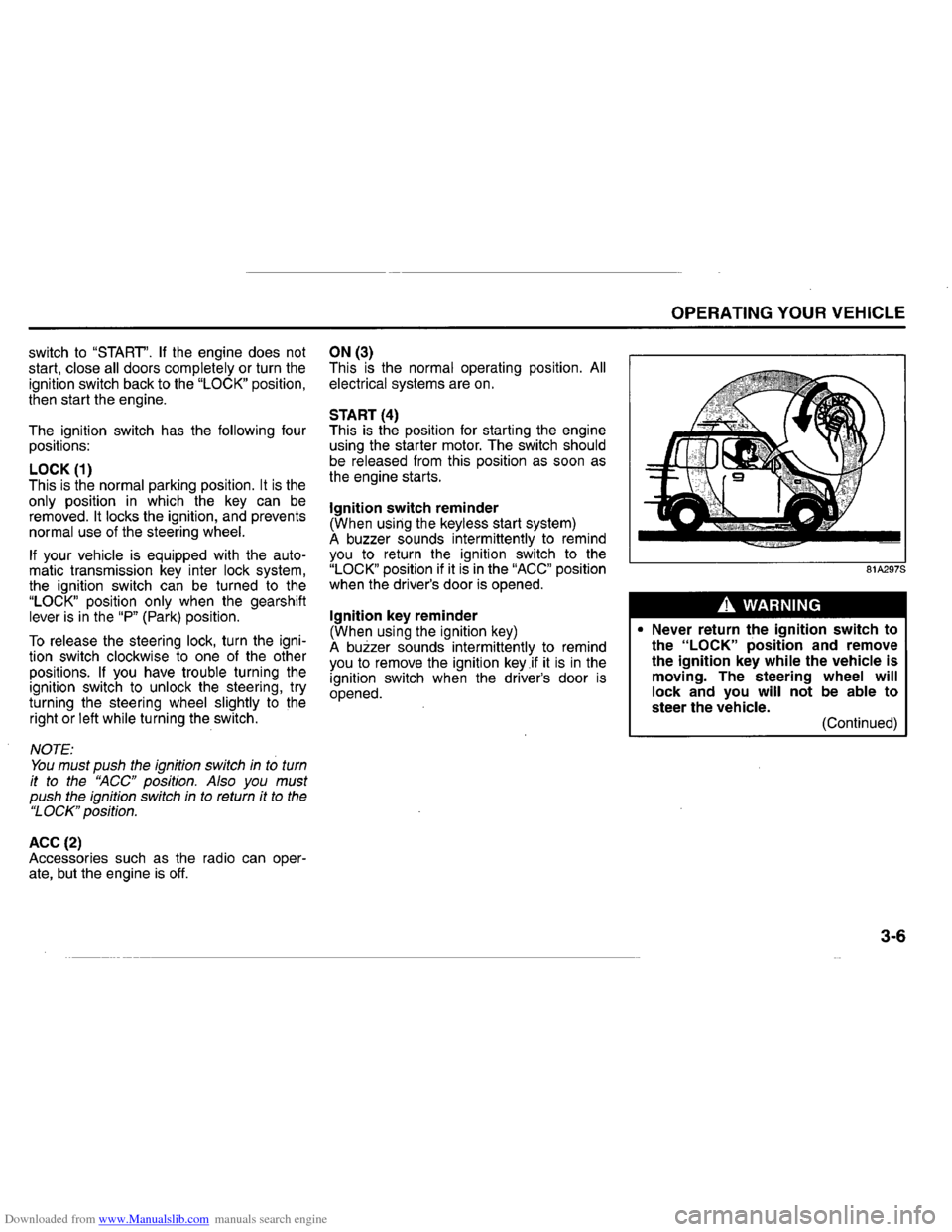
Downloaded from www.Manualslib.com manuals search engine switch to "START'. If the engine does not
start, close all doors completely or turn the
ignition switch back to the "LOCK" position,
then start the engine.
The ignition switch has the
following four
positions:
LOCK (1) This is the normal parking position. It is the only position in which the key can be
removed. It locks the ignition, and prevents normal use of the steering wheel.
If
your vehicle is equipped with the auto
matic transmission key inter lock system,
the ignition switch can be turned to the
"LOCK" position only when the gearshift lever is in the "P" (Park) position.
To release the steering lock, turn the igni
tion switch clockwise to one of the other
positions. If you have trouble turning the
ignition switch to unlock the steering, try
turning the steering wheel slightly to the
right or left while turning the switch.
NOTE: You must push the ignition switch in to turn
it to the '~CC" position. Also you must
push the ignition switch in to return it to the "LOCK" position.
ACC (2) Accessories such as the radio can oper
ate, but the engine is off.
ON (3)
This is the normal operating position. All
electrical systems are on.
START (4)
This is the position for starting the engine
using the starter motor. The switch should be released from this position as soon as
the engine starts.
Ignition switch reminder (When using the keyless start system)
A buzzer sounds intermittently to remind
you to return the ignition switch to the
"LOCK" position if it is in the "ACC" position
when the driver's door is opened.
Ignition key reminder (When using the ignition key)
A buzzer sounds intermittently to remind
you to remove the ignition
key if it is in the
ignition switch when the driver's door is opened.
OPERATING YOUR VEHICLE
81A297S
A WARNING
• Never return the ignition switch to the "LOCK" position and remove
the ignition key while the vehicle is moving. The steering wheel will lock and you will not be able to steer the vehicle. (Continued)
3-6
Page 8 of 40
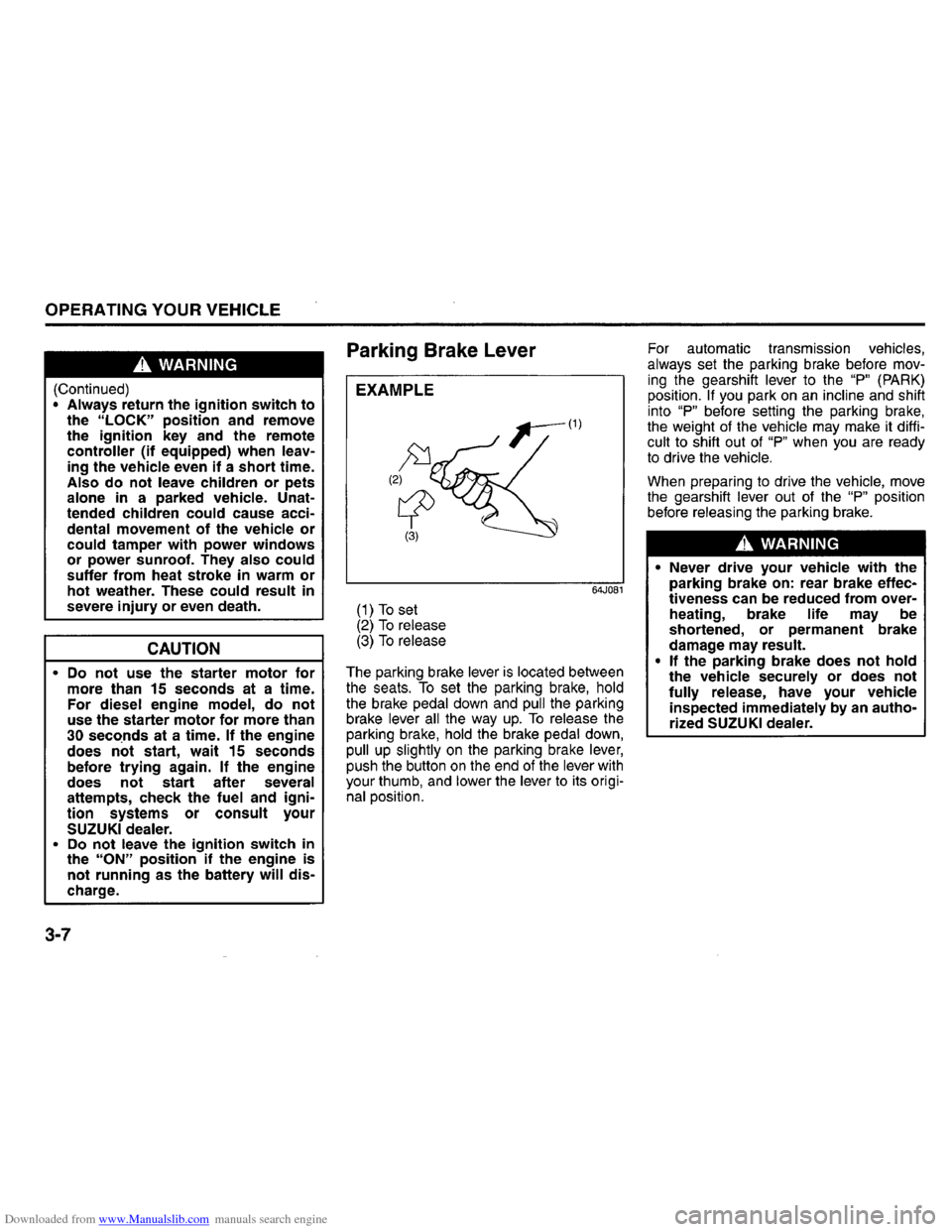
Downloaded from www.Manualslib.com manuals search engine OPERATING YOUR VEHICLE
A. WARNING
(Continued) • Always return the ignition switch to the "LOCK" position and remove
the ignition key and the remote controller (if equipped) when leaving the vehicle even if a short time. Also do not leave children or pets alone in a parked vehicle. Unat
tended children could cause accidental movement of the vehicle or could tamper with power windows or power sunroof. They also could suffer from heat stroke in warm or hot weather. These could result in
severe injury or even death.
CAUTION
• Do not use the starter motor for more than 15 seconds at a time.
For diesel engine model, do not use the starter motor for more than 30 seconds at a time. If the engine
does not start, wait 15 seconds
before trying again. If the engine
does not start after several attempts, check the fuel and ignition systems or consult your SUZUKI dealer.
• Do not leave the ignition switch in
the "ON" position if the engine is not running as the battery will discharge.
3-7
Parking Brake Lever
EXAMPLE
(1) To set (2) To release (3) To release
64J081
The parking brake lever is located between the seats. To set the parking brake, hold the brake pedal down and pull the parking
brake lever all the way up. To release the parking brake, hold the brake pedal down, pull up slightly on the parking brake lever, push the button on the end of the lever with
your thumb, and lower the lever to its original position. For
automatic transmission
vehicles,
always set the parking brake before moving the gearshift lever to the "P" (PARK) position. If you park on an incline and shift
into "P" before setting the parking brake, the weight of the vehicle may make it difficult to shift out of "P" when you are ready to drive the vehicle.
When preparing to drive the vehicle, move the gearshift lever out of the "P" position
before releasing the parking brake.
A. WARNING
• Never drive your vehicle with the
parking brake on: rear brake effec
tiveness can be reduced from over
heating, brake life may be
shortened,
or permanent brake
damage may result.
• If
the parking brake does not hold the vehicle securely or does not fully release, have your vehicle inspected immediately by an autho
rized SUZUKI dealer.
Page 11 of 40

Downloaded from www.Manualslib.com manuals search engine Starting a Cold and Warm Engine
(For Gasoline Engine Model) With your foot off the ~cceler~to~. pedal,
crank the engine by turning the Ignition key to "START". Release the key when the
engine starts.
CAUTION
• Stop turning the starter immediately after the engine has started or the starter system can be dam-
aged. .
• Do not crank the engine for more
than 15 seconds at a time. If the
engine doesn't start on the first try,
wait about 15 seconds before trying again.
If the engine does not start after 15 seconds of cranking, wait about 15 seconds,
then press down the accele.rator pedal. to 1/3 of its travel and try cranking the engine
again. Release the key and accelerator
pedal when the engine starts.
If the engine still does not start, try holding
the accelerator pedal all the way to the
floor while cranking. This should clear the
engine if it
is flooded.
(For Diesel Engine Model)
Cold engine Turn the ignition switch to the. "~N" position and wait until the glow plug Indicator goes
out if it comes on. Crank the engine by turning the ignition key to "START". Release the key when the engine starts.
CAUTION
• The starter is allowed to crank the
engine up to 30 secon~s. If the
engine failed to start, walt 15 seconds, then restart cranking. Even if the third trial failed, consult authorized SUZUKI dealer. • If the engine is started after long
time parking at extremely cold
atmosphere such as the ambient
temperature
is below -20o~, release ignition key from start POSItion and stop cranking after confirming the engine speed increase
around 800 to 1000 rpm.
Warm engine
Crank the engine by turning the ignition
key to "START". Release the key when the engine starts.
OPERATING YOUR VEHICLE
Caution when stopping the engine with turbocharger
When stopping the engine after ~Iim~ing or high speed driving, let the ~n.gl~e Idle for
about one minute or more (If It IS not prohibited) to cool down the turbocharg~r an~ engine oil. This is to pr~vent the en!;llne 011 from over-deteriorating. Deteriorated
engine oil will damage the bearings of the
turbocharger.
Restarting
F9Q diesel engine after fuelempty stop
The engine stops if the engi~e feels fuel
emptiness. To restart the engine, stop the vehicle, fill the tank (minimum 5 liters) and
operate the manual priming pump (1) attached to the fuel filter until resistance is felt. Then perform the engine starting procedure.
3-10
Page 18 of 40
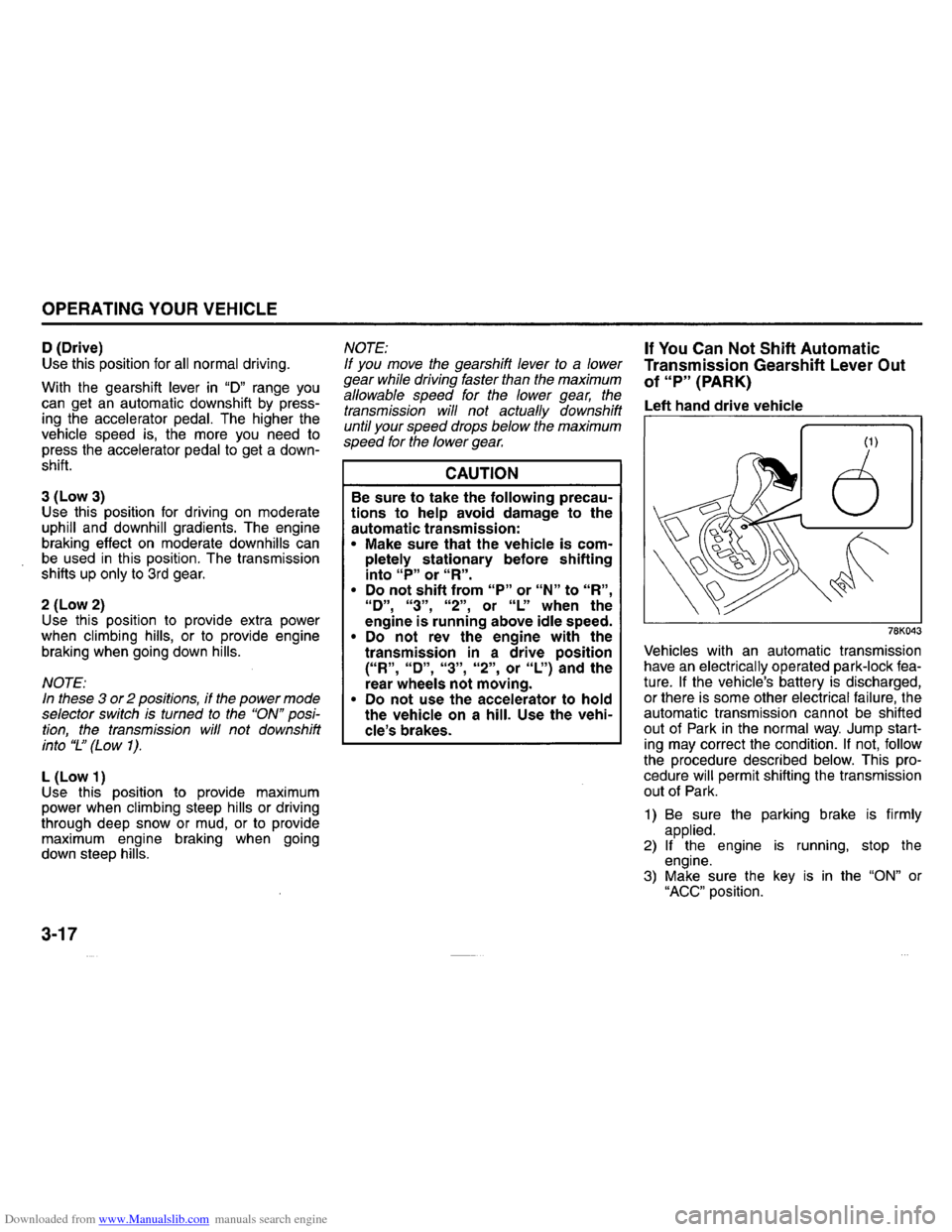
Downloaded from www.Manualslib.com manuals search engine OPERATING YOUR VEHICLE
o (Drive)
Use this position for all normal driving.
With the gearshift
lever in "D" range you can get an automatic downshift by press
ing the accelerator pedal. The higher the
vehicle speed is, the more you need to
press the accelerator pedal to get a down
shift.
3
(Low 3) Use this position for driving on moderate uphill and downhill gradients. The engine
braking effect on moderate down hills can be used in this position. The transmission
shifts up only to 3rd gear.
2 (Low 2) Use this position to provide extra power
when climbing hills, or to provide engine
braking when going down hills.
NOTE: In these 3 or 2 positions, if the power mode
selector switch is turned to the "ON" position, the transmission will not downshift
into "L.:' (Low 1).
L (Low 1)
Use this position to provide maximum
power when climbing steep
hills or driving
through deep snow or mud, or to provide
maximum engine braking when going
down steep hills.
3-17
NOTE:
If you move the gearshift lever to a lower
gear while driving faster than the maximum
allowable speed for the lower gear, the
transmission will not actually downshift
until your speed drops below the maximum
speed for
the lower gear.
CAUTION
Be sure to take the following precautions to help avoid damage to the
automatic transmission:
• Make sure that the vehicle is completely stationary before shifting into "P" or "R". • Do not shift from "P" or "N" to "R", "0", "3", "2", or "L:' when the
engine is running above idle speed. • Do not rev the engine with the transmission in a drive position ("R", "0", "3", "2", or "L:') and the rear wheels not moving. • Do not use the accelerator to hold the vehicle on a hill. Use the vehicle's brakes.
If You Can Not Shift Automatic
Transmission Gearshift Lever
Out
of "P" (PARK)
Left hand drive vehicle
78K043
Vehicles with an automatic transmission
have an electrically operated park-lock fea
ture. If the vehicle's battery is discharged,
or there is some other electrical failure, the
automatic transmission cannot be shifted
out of Park in the normal way. Jump start
ing may correct the condition. If not, follow the procedure described below. This pro
cedure will permit shifting the transmission
out of Park.
1) Be sure the parking brake is firmly
applied.
2) If the engine is running, stop the
engine.
3) Make sure the key is in the "ON" or "ACC" position.
Page 19 of 40
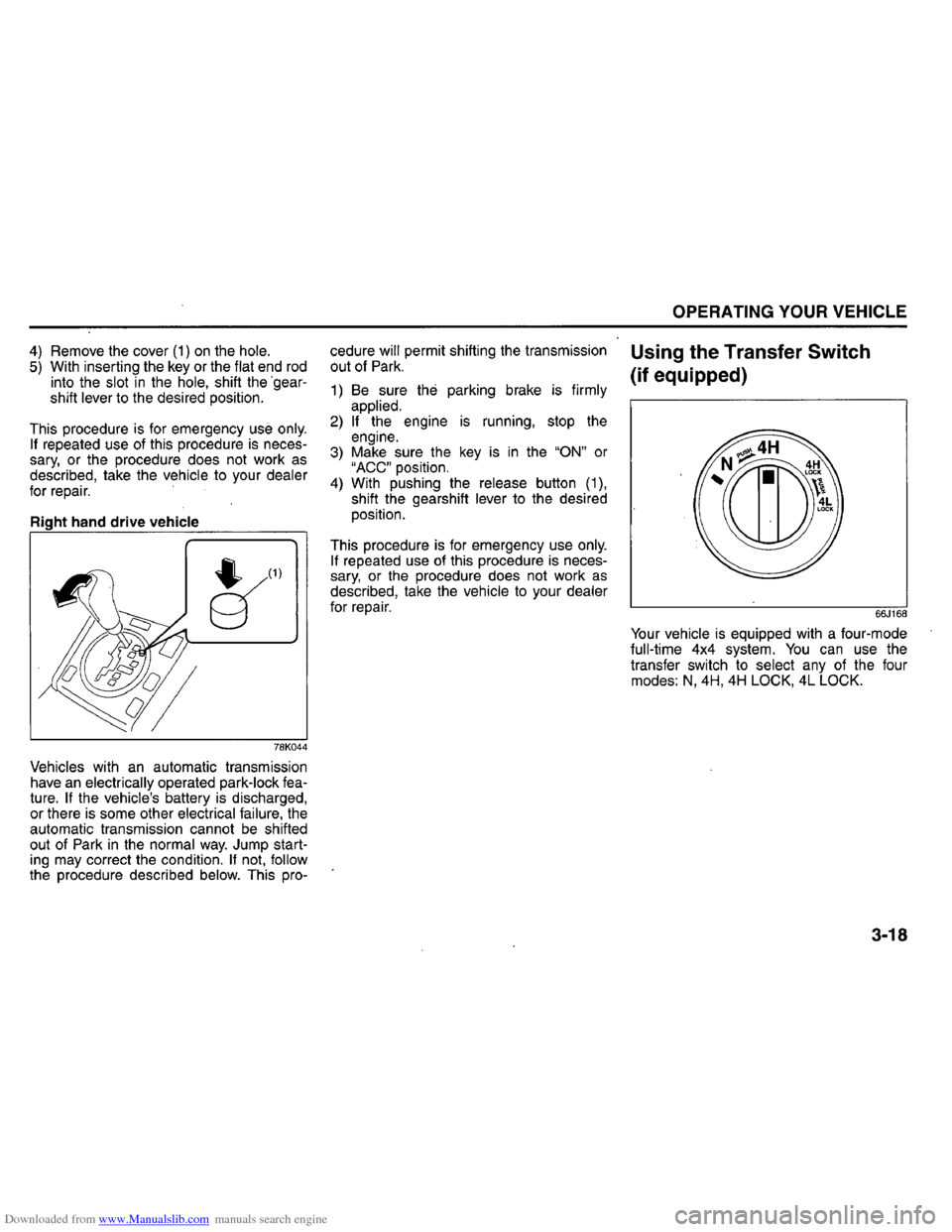
Downloaded from www.Manualslib.com manuals search engine 4) Remove the cover (1) on the hole. 5) With inserting the key or the flat end rod into the slot in the hole, shift the 'gear
shift lever to the desired position.
This procedure
is for emergency use only. If repeated use of this procedure is necessary, or the procedure does not work as described, take the vehicle to your dealer for repair. '
Right hand drive vehicle
~(1)
78K044
Vehicles with an automatic transmission have an electrically operated park-lock fea
ture. If the vehicle's battery is discharged,
or there is some other electrical failure, the
automatic transmission cannot be shifted
out of Park in the normal way. Jump start
ing may correct the condition. If not, follow the procedure described below. This pro- cedure
will permit shifting the transmission
out of
Park.
1) Be sure the parking brake is firmly
applied.
2) If the engine is running, stop the
engine.
3) Make sure the key is in the "ON" or "ACC" position. 4) With pushing the release button (1),
shift the gearshift lever to the desired
position.
This procedure
is for emergency use only. If repeated use of this procedure is necessary, or the procedure does not work as described, take the vehicle to your dealer for repair.
OPERATING YOUR VEHICLE
Using the Transfer Switch
(if equipped)
66J168
Your vehicle is equipped with a four-mode full-time 4x4 system. You can use the
transfer switch to select any of the four
modes: N, 4H, 4H LOCK, 4L LOCK.
3-18